After nine months of consultation, the ║├╔½Ž╚╔·TV the Future Commission gathered the industry together in Westminster to discuss solutions to improve the built environment. Carl Brown and Tom Lane report
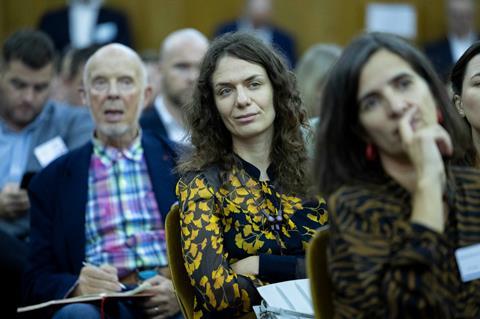
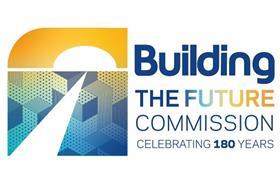
In the Assembly Hall Theatre at grade II-listed Church House in Westminster hundreds of professionals from construction, architecture and housing gathered to listen to speakers and panellists talking about ideas to improve the built environment.
At the same time many were tapping on their devices, voting electronically in polls on key solutions and barriers or submitting questions to the commission. And in a room nearby audience members were giving their views on camera to a TV crew.

║├╔½Ž╚╔·TVŌĆÖs interactive ║├╔½Ž╚╔·TV the Future Commission conference last month saw a whole afternoon of debate as the year-long project, launched to mark ║├╔½Ž╚╔·TVŌĆÖs 180th anniversary, prepared to enter the final quarter of the year.
After nine months of regional roundtables, investigations and consultations with the industry and our panel of 19 experts - as well as dozens and dozens of articles - we brought the industry together to help formulate our thinking ahead of the commissionŌĆÖs final report due to be published at the end of the year.
Chloe McCulloch, editorial director at ║├╔½Ž╚╔·TV, spoke about thecommissionŌĆÖs interim findings, published last month, in her opening address.
She said: ŌĆ£We can see some strong themes coming through the commissionŌĆÖs work. There is a huge desire among those working in the industry to unite around a positive vision from constructionŌĆÖs future but this is twinned with a frustration at a lack of joined-up thinking at government level and a lack of co-ordination among companies.
ŌĆ£If we can get over some of these hurdles, there is a strong belief that construction can help UK plc be a success. For this reason the commission is calling on government to commit to a long-term strategic plan to increase constructionŌĆÖs productivity, boost economic growth and improve the quality of the UKŌĆÖs built environment.ŌĆØ
Here we bring together some highlights from the conference and consider the key messages that will help the commission formulate its final conclusions.
The net zero panel debate: How is the net zero agenda transforming the built environment?
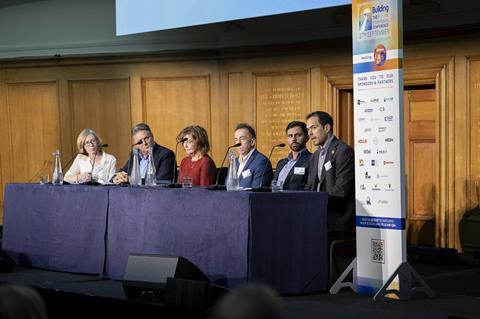
The interim findings of the ║├╔½Ž╚╔·TV the Future Commission suggested that the materials needed to achieve net zero are expensive and the skills limited. Cost pressures have been exacerbated by inflation which is impacting on project viability which means net zero aspirations are being scaled back. A second challenge is the lack of joined up net zero policies, for example there is no regulation of embodied carbon.
Confidence in government policy has been undermined by the recent announcement that the deadlines for phasing out fossil fuel boilers were being pushed back and there would no longer be a requirement for landlords to upgrade their properties to an EPC rating by 2026.
ItŌĆÖs amazing how much the industry has upped its game in the last couple of years
Lynne Sullivan, National Retrofit Hub
Despite this, our net zero panel was positive about progress towards net zero. ŌĆ£ItŌĆÖs amazing how much the industry has upped its game in the last couple of years,ŌĆØ said Lynn Sullivan, the chair of the National Retrofit Hub said. ŌĆ£Awareness of scope one, two and three emissions is becoming a very noticeable driver which is cascading down through the industry down to the smaller businesses.ŌĆØ
The commercial sector is making particularly good progress, despite government flip flopping on net zero policy, because of pressure from the environmental, social and governance (ESG) requirements of funders.
Financial institutions work across borders, so it doesnŌĆÖt matter where government regulation is coming from
Simon Wyatt, Cundall
ŌĆ£Financial institutions work across borders, so it doesnŌĆÖt matter where government regulation is coming from,ŌĆØ said Simon Wyatt, the sustainability partner at Cundall. ŌĆ£If you want access to funding and then you need to basically be meeting these ESG standards.ŌĆØ
According to Sullivan the risk of stranded asset syndrome is a big driver too. This is a phenomenon where a building becomes worthless because poor energy performance means canŌĆÖt be let. ŌĆ£This isnŌĆÖt just confined to the commercial sector, it is also true of the housing sector,ŌĆØ she said. ŌĆ£Major housing asset managers are now looking at auditing the resilience of their stock and potentially offloading hard to treat properties.ŌĆØ She added that buildings that perform well command a premium which offsets the increase in capital cost. ŌĆ£Values that have been collected by the Passivhaus community show an uplift in value of at least 5% which is counterbalancing the extra over costs [of construction].ŌĆØ
The costs of retrofitting existing homes is a particular challenge because owner occupiers are not subject to any regulatory or ESG funding pressure. And they must find a large upfront sum to fund the work which could take many years to pay back. Sullivan saidsa costs could be reduced by identifying what retrofit interventions are proved to work for a range of different house types and forms of construction. From this a pattern book of solutions could be adopted and potentially linked to a pay as you save mechanism where the energy savings are used to repay the loan to do the work. She added energy efficiency improvements would reduce the costs of upgrading the electricity grid too. For Wyatt a drive to reduce scope 3 emissions ŌĆō those not directly produced by a business but its supply chain ŌĆō could prompt firms to retrofit the homes of their work from home employees.
Regarding future government policy Wyatt said last year the Environmental Audit Committee recommended embodied carbon should be regulated and that there should be mandatory operational energy standards. Regarding the latter the industry has drafted Part Z, which is ready to go and the and published a consultation on a national framework for monitoring the energy performance of large buildings. A new government could potentially give the green light to these which would be a big push on the journey towards a net zero built environment.
Messages from the keynote speakers
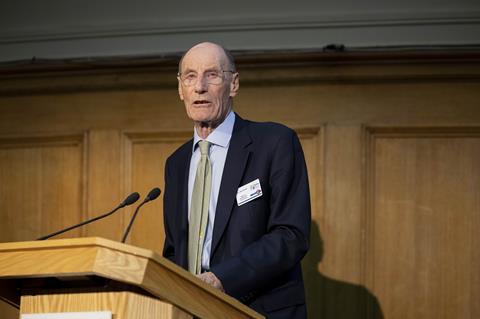
ŌĆ£While politics will never be removed from infrastructure, and ministers will understandably want to shape the direction of major programmes, we need to face up to the implications of chopping and changing policy.
ŌĆ£Ultimately, politicians are there to take the tough decisions. But if the private sector is to play its part in delivering major public objectives ŌĆō whether that is net zero, or levelling up, or even meeting the housebuilding target ŌĆō it needs a stable policy and regulatory environment.
ŌĆ£That is best achieved through a long-term plan that is forged collaboratively between public and private sectors, including regulators ŌĆō and then, crucially, sticking to it. This is the missing link between high level plans and targets, and getting stuff done on the ground.ŌĆØ
Sir John Armitt, chair of the National Infrastructure Commission

ŌĆ£As leaders we can be futurologists, we can use facts to build potential future outcomes.
ŌĆ£If we donŌĆÖt consider the future, how will we know if weŌĆÖve got the right skills for the future of construction, let alone the numbers we need,ŌĆØ she said.
ŌĆ£If we donŌĆÖt plan a pathway, invest in materials, plant new ways of working. how can we find a route to net zero construction? ŌĆ£If we donŌĆÖt find new ways of working, new ways of navigating the planning system, how on earth will we ever have all the housing that we need?ŌĆØ
Katy Dowding, president and chief executive, Skanska UK
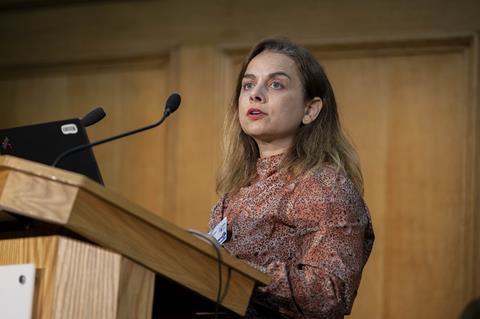
ŌĆ£Collaboration in design is not only about software but spaces and experiences, as designers we are in the business of creating experiences.
ŌĆ£Creative minds have nothing to fear from the advent of technological revolution if we play our cards right. AI is not meant to replace us but rather augment our creativity and problem-solving capacity
ŌĆ£To harness the power of AI we first need to be able to control what powers it, which is data.ŌĆØ
ŌĆ£We have developed an app that can make design suggestions as our designers change the massing of our buildings.ŌĆØ
Martha Tsigkari, head of applied R&D, Fosters + Partners
Key takeways for the commission
- The industry wants stability ŌĆō ŌĆ£frequent government policy U-turns that put off private sector investmentŌĆØ was cited by most attendees as the biggest challenge facing construction today
- Whether it be reforming planning, or improving data sharing, there is a desire to work with existing structures, rather than trying to reinvent the wheel
- Collaboration - throughout the day the importance of all parts of the industry to work together to address challenges such as net zero, building safety, and productivity was a constant theme
- Data-sharing, and understanding data more broadly, is crucial and the audience see potential in digital technology to achieve this
- The idea of regulating embodied carbon is worthy of investigation
- Solutions should be adopted to help with the retrofitting of existing homes, particularly for owner occupiers.
Digital technology debate: How will the digital revolution reshape the sector?

Digital technologies have a critical role in improving constructionŌĆÖs poor productivity. Although firms are making progress towards greater digitisation the ║├╔½Ž╚╔·TV the Future Commission found that this is not evenly distributed across the industry. Another big barrier to more effective digital ways of working is poor quality data which hinders collaboration and limits the use of game changing tools such as artificial intelligence.
Paul Drayton, Laing OŌĆÖRourkeŌĆÖs head of digital for Europe, said digital processes are becoming increasingly important to clients but despite this, digital adoption is still a challenge. Part of this is working out which tools and processes add the maximum value, adopting these and ensuring that these endure to become business as usual.
He said part of the problem is there are too many tools with something new coming out each week. ŌĆ£We need to be pretty ruthless in terms of defining whatŌĆÖs the problem that we are trying to solve and how are we going to measure the impact of a solution to know whether it is successful or not,ŌĆØ he explains. ŌĆ£There are things available to today with so much latent potential, we donŌĆÖt need to find the latest and greatest but get more out of what we have got already.ŌĆØ
The panel agreed that bringing people along on the digital journey was far more important ŌĆō and challenging - than technology.
This includes giving people tools appropriate to their level of digital understanding. Chris Bowie-Hill, HydrockŌĆÖs director of innovation delivery job involves working with the asset managers of large public sector estates to understand and improve these in the most effective way. This involves working with a wide range of people which includes those who use pen and paper to take meter readings.
The trendsetter isnŌĆÖt the important person. The first follower is how you start a movement and get a cascade through a business
Paul Drayton, Laing OŌĆÖRourke
Capturing that data digitally and combining it with other parameters such a buildings size and number of occupants makes it much easier to develop a decarbonisation programme. Digital twins are the ultimate tool for effective asset management but Bowie-Hill said people need to start with more basic tools before moving up. ŌĆ£Over time we will move closer and closer to that all singing all dancing digital twin where the estateŌĆÖs running itself,ŌĆØ he said.
Maria Mamoura is a director in creative technologies at Bryden Wood, a team that includes architects and engineers who are also experts in a range of technologies. They devise new tools including design automation software. She echoes the commissionŌĆÖs finding that poor quality data is an issue. ŌĆ£The first step is that we need to get information in the form of a dataset,ŌĆØ she said. ŌĆ£No matter what it is, as soon as it is in a machine readable format we can do many things afterwards.ŌĆØ This includes using this data to develop those new tools accessible to all. ŌĆ£Those experts in technologies should bring information back in a simplified format that is easy to consume,ŌĆØ she said.
How does the industry address the fact it lags far behind other sectors when it comes to digital adoption? Bowie-Hill said a bottom up and top down approach within organisations is needed. The bottom up aspect should be more straightforward because people are starting out and are more likely to be digital natives. The challenge is in the boardroom where people are older. ŌĆ£ThereŌĆÖs probably some nervousness at that higher level because those people have never really had to get involved with sophisticated digital tools,ŌĆØ he said. ŌĆ£If we can identify where the opportunities and pinch points are for that group that will allow that top down to happen much more quickly.
Drayton advocates the digital follower as a key driver for this journey. This is the person who is the first to follow a trend set by someone else. ŌĆ£The trendsetter isnŌĆÖt the important person,ŌĆØ he said. ŌĆ£The first follower is how you start a movement and get a cascade through a business.ŌĆØ
║├╔½Ž╚╔·TV safety debate

A frequent theme of the conference, and indeed the whole commission to date, has been frustration at uncertainty in government policy.
Peter Caplehorn, chief executive of the Construction Products Association, certainly railed against ŌĆ£disruption, change and incoherenceŌĆØ in his address to the conference. Caplehorn said we need to have consistent, long-term planning and policies that allow companies to ŌĆ£invest and where maturity of process and support systems can developŌĆØ.
But the bigger point from the panel is that it is up to the industry itself to work together to ensure these processes are developed to make buildings safer and in compliance with the ║├╔½Ž╚╔·TV Safety Act.
Caplehorn said he hopes the new Code for Construction Product Information will help usher in a period where product information will ŌĆ£become clear, reliable, up-to-date accurate and above all trustworthyŌĆØ, saying it was the concerns about trust that was most shocking following Grenfell.
He said any product information not part of the code process should be challenged.
WeŌĆÖve got good systems in place, we need to use them, take responsibility and do it collectively
Suzannah Nichol, chief executive of Build UK
Collaboration was also a big theme. Suzannah Nichol, chief executive of Build UK, warned firms about working in silos, getting mired in bureaucracy and adding layers of duplication.
She said: ŌĆ£WeŌĆÖve got good systems in place, we need to use them, take responsibility and do it collectively. If we all go away and do our different things we are going to stay as we are.ŌĆØ
Andrew Mellor, partner at PRP and a ║├╔½Ž╚╔·TV the Future commissioner, gave an example of collaboration in action. He said architectural practices, who havenŌĆÖt worked together before as rivals, have been getting together to produce ŌĆ£standard question checklistsŌĆØ to try and ensure a more uniform approach to complying with the Principle Designer requirements under the act.
ŌĆ£ItŌĆÖs like a pilotŌĆÖs checklist, if anything on that checklist is not ticked off the plane is going nowhere,ŌĆØ he said.
Understanding of responsibility and accountability was also a point of discussion. Amanda Stubbs, partner at Trowers and Hamlins, likened understanding of risk to a game of ŌĆ£pass the parcel between the dutyholdersŌĆØ. She said: ŌĆ£You get the parcel and then are you trying to shift it quickly, or are you actually stopping to think what youŌĆÖve got in your hand?ŌĆØ
She said the industry is still not geared up to understanding this. Ben Smallwood, major projects business manager at LABC Warranty, said longer warranty periods coming in could lead to more scrutiny for manufacturers, meaning they need to assess their quality control procedures, or invest in research and development to ensure product longevity.
Nichol said the new regime means ŌĆ£there will be no hiding placesŌĆØ and everyone is ŌĆ£held accountable by each other, the regulator and by the occupier.ŌĆØ
But firms will only be able to collaborate, understand risk and take responsibility if they have the necessary skills to enable it.
A poll of the audience (see below) in the building safety session revealed concern in this area. When asked about the ŌĆ£biggest barrier preventing firms from being ready for the ║├╔½Ž╚╔·TV Safety ActŌĆØ more than half the audience (53%) answered ŌĆślack of education, training and skills.ŌĆØ
Caplehorn pointed out its ŌĆ£no good ensuirng [product] information is precise if we donŌĆÖt have workforce that understands what we are dealing with. Mellor meanwhile, raised the issue of whether clients ŌĆ£have the competence to assess the competenceŌĆØ again saying there are systems in place to help achieve this.
So the message on building safety is we need collaboration, information-sharing through the new CCPI, long-term certainty, and a focus on improving training, skills and competence.
Audience polls
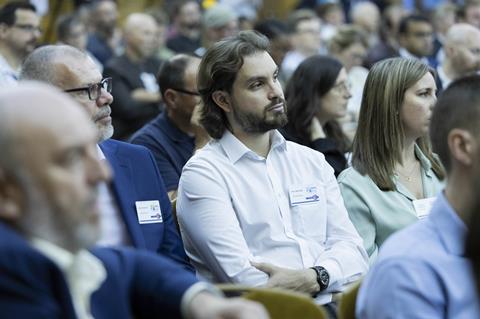
The audience was asked to vote on multiple choice questions throughout the day. The picture given is that construction professionals are concerned that a lack of skills will hamper attempts to build and retrofit buildings to new standards and to ensure firms are ready for the ║├╔½Ž╚╔·TV Safety Act.
ŌĆ£Frequent government policy U-turns that put off private sector investmentŌĆØ was cited by most people as the biggest challenge the industry, while there was hope that the creation of ŌĆ£Industry-wide standards for data sharingŌĆØ could be the biggest positive change through digital technology.
>
The conference saw the launch of the ║├╔½Ž╚╔·TV the Future CommissionŌĆÖs 20-page report looking at how we can reform the English planning system.
The reportŌĆÖs author, ║├╔½Ž╚╔·TVŌĆÖs contributing editor Joey Gardiner. carried out phone interviews, questionnaires and roundtables with experts as part of an investigation spanning several months.
At the conference he said: ŌĆ£I think the most shocking thing really is it [the findings] just reinforced the state that the planning system is in.
ŌĆ£Just 15% of, of all planning applications are decided within the statutory 13 week period. According to LichfieldsŌĆÖ latest research, the average planning application is now taking a year to be decided, and at the same time the number of permissions being granted each year has been falling.
ŌĆ£What weŌĆÖre saying we want to do here is [make] a series of discrete but significant changes that give the existing system a chance to work.
ŌĆ£If we sort resources, sort strategic planning and housing numbers and sort local plans, then actually we can get the current system working properly.ŌĆØ


























No comments yet